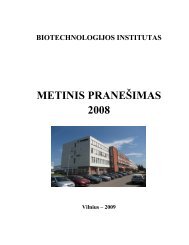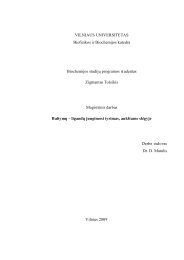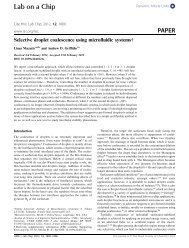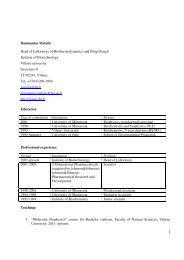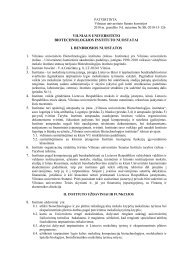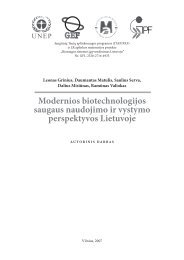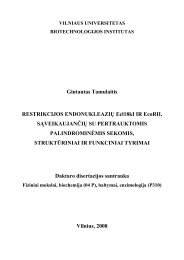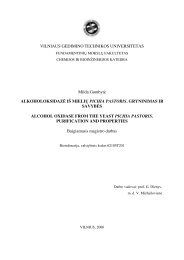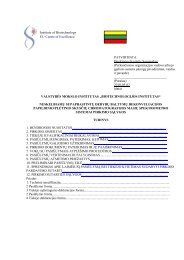Biennial Report 2011â2012
Biennial Report 2011â2012
Biennial Report 2011â2012
You also want an ePaper? Increase the reach of your titles
YUMPU automatically turns print PDFs into web optimized ePapers that Google loves.
AdoMet-dependent methyltransferases (MTases), which represent<br />
more than 3% of the proteins in the cell, catalyze the<br />
transfer of the methyl group from S-adenosyl-L-methionine<br />
(SAM or AdoMet) to N-, C-, O- or S-nucleophiles in DNA,<br />
RNA, proteins or small biomolecules. In DNA of mammals,<br />
cytosines are often methylated at the 5-position of the pyrimidine<br />
ring to give 5-methylcytosine (5mC). In somatic cells,<br />
5mC is largely restricted to CpG sites. DNA methylation profiles<br />
are highly variable across different genetic loci, cells and<br />
organisms, and are dependent on tissue, age, sex, diet, and disease.<br />
Besides 5mC, certain genomic DNAs have been shown<br />
to contain substantial amounts of 5-hydroxymethyl-cytosine<br />
(hmC). It was demonstrated that hmC is predominantly produced<br />
via oxidation of 5mC residues by TET oxygenases and<br />
that the Tet proteins have the capacity to further oxidize hmC<br />
forming 5-formylcytosine (fC) and 5-carboxylcytosine (caC)<br />
(Fig. 1). Altogether, current evidence suggests that hmC, fC<br />
and caC are intermediates on the pathway of active DNA demethylation,<br />
and the multiplicity of epigenetic states may also<br />
play independent roles in embryonic development, brain function<br />
and cancer progression. Therefore, a full appreciation of<br />
the biological significance of epigenetic regulation in mammals<br />
will require the development of novel tools that allow hmC,<br />
5mC and C to be distinguished unequivocally. We therefore<br />
aim to develop new approaches for genome-wide profiling of<br />
biological DNA modifications for epigenome studies and improved<br />
diagnostics.<br />
Besides their diverse biological roles, DNA MTases are attractive<br />
models for studying structural aspects of DNA-protein interaction.<br />
Bacterial enzymes recognize an impressive variety (over 300)<br />
of short sequences in DNA. As shown first for the HhaI MTase,<br />
access to the target base, which is buried within the stacked double<br />
helix, is gained in a remarkably elegant manner: by rotating<br />
the nucleotide completely out of the DNA helix and into a<br />
concave catalytic pocket in the enzyme. This general mechanistic<br />
feature named “base-flipping” is shared by numerous other<br />
DNA repair and DNA modifying enzymes. Our laboratory has<br />
a long standing interest in studies of the mechanistic and structural<br />
aspects of DNA methylation using the HhaI DNA cytosine-5<br />
methyltransferase (M.HhaI, recognition target GCGC)<br />
from the bacterium Haemophilus haemolyticus as the paradigm<br />
model system. The ability of most MTases to catalyze highly specific<br />
covalent modifications of biopolymers makes them attractive<br />
molecular tools, provided that the transfer of larger chemical<br />
entities can be achieved. Our goal is to redesign the enzymatic<br />
methyltransferase reactions for targeted covalent deposition of<br />
desired functional or reporter groups onto biopolymer molecules<br />
such as DNA and RNA.<br />
Figure 1. Formation and removal of epigenetic marks in mammalian<br />
DNA. Cytosine (C) is converted to 5-methylcytosine (5mC) by action of<br />
endogenous DNA MTases of Dnmt1 and Dnmt3 families (green pathway).<br />
Several mechanisms for DNA demethylation, in which 5-methylcytosine<br />
(5mC) is converted back to C, have been proposed. Horizontal<br />
arrows represent oxidation-based pathways performed by Tet proteins:<br />
methyl group of mC is consecutively oxidized to hydroxymethyl, formyl<br />
and carboxyl groups forming 5-hydroxymethylcytosine (hmC), 5-formylcytosine<br />
(fC) and 5-carboxycytosine (caC), respectively. Bent plain arrows<br />
show deamination-based pathways where hmC is deaminated to 5-hydroxymethyluracil<br />
(hmU) in the presence of AID/APOBEC family deaminases,<br />
and direct base excision repair (BER) pathways involving TDG,<br />
MBD4 and SMUG1 glycosylases, which all lead to transient formation of<br />
apyrimidinic (AP) sites in DNA. Dashed arrows denote the newly discovered<br />
hydroxymethylation and dehydroxymethylation reactions performed<br />
by cytosine-5 methyltransferases in vitro and putative enzymes (deformylase<br />
and decarboxylase) which could directly remove the formyl and carboxyl<br />
groups from fC and caC, respectively (reviewed in [6]).<br />
Vilnius University Institute of Biotechnology <strong>Biennial</strong> report for 2011–2012 35



